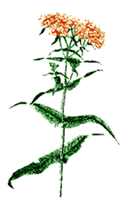
Boneset
Introduction
This fact sheet provides basic information about Boneset. Boneset is a ubiquitous plant found growing in swamps, marshes, and shores from Canada to Florida and west to Texas and Nebraska.
Common Names
Boneset, Thoroughwort, Vegetable Antimony, Feverwort, Agueweed, Indian Sage, Sweating Plant, Eupatorium, Crosswort, Thoroughstem, Thoroughwax, Wild Isaac
Latin Names
upatorium perfoliatum
What It Is Used For
- The early settlers used the plant to treat rheumatism, dropsy, dengue fever, malaria, pneumonia, and influenza. The name boneset was derived from the plant's use in the treatment of breakbone fever, a term describing the high fever that often accompanies influenza.
How It Is Used
Boneset has been traditionally taken as a tea or tincture. To prepare the tea, add boiling water to 1/4-1/2 teaspoon (1-2 grams) of the herb. Allow it to steep covered for ten to fifteen minutes. Three cups (750 ml) a day may be taken (the tea is fairly bitter). Tincture, 1/4-3/4 teaspoon (1-4 ml) three times daily, is also taken often.
What the Science Says
- Although few reports of adverse effects have been reported with the use of boneset, the FDA has classified this plant as an "Herb of Undefined Safety."
Side Effects and Cautions
- The ingestion of large amounts of teas or extracts may result in severe diarrhea.
Sources







